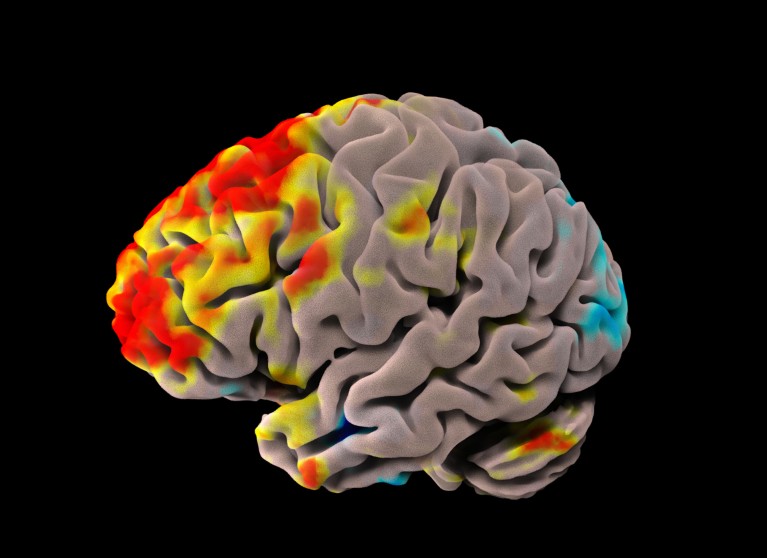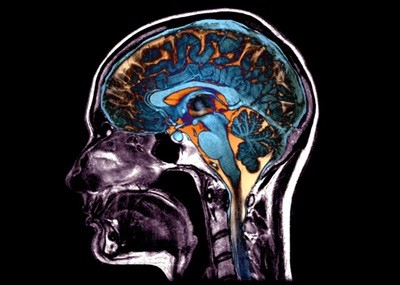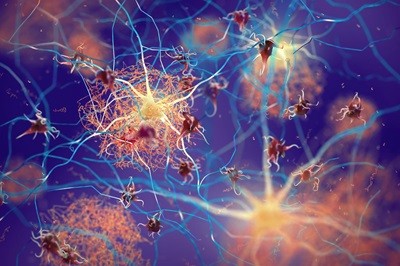What accelerates brain ageing? This AI ‘brain clock’ points to answers


A functional magnetic resonance imaging scan (artificially coloured) of a human brain. Researchers used data from such scans to measure an aspect of brain ageing.Credit: Mark and Mary Stevens Neuroimaging and Informatics Institute/Science Photo Library
A newly devised ‘brain clock’ can determine whether a person’s brain is ageing faster than their chronological age would suggest1. Brains age faster in women, countries with more inequality and Latin American countries, the clock indicates.
“The way your brain ages, it’s not just about years. It’s about where you live, what you do, your socioeconomic level, the level of pollution you have in your environment,” says Agustín Ibáñez, the study’s lead author and a neuroscientist at Adolfo Ibáñez University in Santiago. “Any country that wants to invest in the brain health of the people, they need to address structural inequalities.”
The work is “truly impressive”, says neuroscientist Vladimir Hachinski at Western University in London, Canada, who was not involved in the study. It was published 26 August in Nature Medicine.
Only connect
The researchers looked at brain ageing by assessing a complex form of functional connectivity, a measure of the extent to which brain regions are interacting with one another. Functional connectivity generally declines with age.
The authors drew on data from 15 countries: 7 (Mexico, Cuba, Colombia, Peru, Brazil, Chile and Argentina) that are in Latin America or the Caribbean and 8 (China, Japan, the United States, Italy, Greece, Turkey, the United Kingdom and Ireland) that are not. Of the 5,306 participants, some were healthy, some had Alzheimer’s disease or another form of dementia and some had mild cognitive impairment, a precursor to dementia.
Five ways the brain can age: 50,000 scans reveal possible patterns of damage
The researchers measured participants’ resting brain activity — that when they were doing nothing in particular — using either functional magnetic resonance imaging (fMRI) or electroencephalography (EEG). The first technique measures blood flow in the brain, and the second measures brain-wave activity.
The authors computed the functional connectivity of each person’s brain and input those data into two deep-learning models trained to predict brain age, one for fMRI data and one for EEG data. They could then calculate each person’s ‘brain-age gap’ — the difference between their chronological age and their brain age estimated from functional connectivity. Having a brain age gap of ten years, for example, would mean that your brain connectivity is roughly the same as that of someone ten years older than you.
Unequal gaps
The models showed that people with Alzheimer’s or another type of dementia had larger brain-age gaps than both those with mild cognitive impairment and healthy controls.
Participants from Latin American or the Caribbean had larger brain-age gaps, on average, than did those from other regions. Latin America is one of the most unequal region in the world, says Ibáñez, and he thinks that this is why the brains of people from that region aged faster. Structural socioeconomic inequality, exposure to air pollution and health disparities were linked to larger brain-age gaps, especially in people from Latin America.
Moreover, women living in countries with high gender inequality — particularly those in Latin America and the Caribbean — tended to have larger brain-age gaps than did men in those countries.
Other clocks, other continents
Simply quantifying brain ageing in a sample this geographically diverse is a phenomenal achievement, says Hachinski. He thinks the conclusion that brain-age gaps vary is solid, but he cautions that functional connectivity is only one way of measuring the health of the brain, and that someone could have a lot of brain connectivity while having, for example, poor mental health due to conditions such as depression or anxiety. Neuroscience is “not good at measuring gestalts”, he says.
Blood tests could soon predict your risk of Alzheimer’s
One possible source of inconsistency in the data is the range of fMRI machines and EEGs — spread across 15 nations — that supplied the brain scans. For example, lower-income nations might have had older equipment that generated lower-quality data than those from higher-income nations. But Ibáñez found no association between lower data quality and either a larger brain-age gap or higher structural inequality.
Now, Ibáñez’s team is investigating whether brain-age gaps are linked to national income by comparing brain-age gaps in groups from Asian nations and the United States, and adding data from ‘epigenetic’ clocks that measure biological age by examining chemical modifications on DNA. Eventually, Ibáñez hopes that the data will contribute to personalized-medicine approaches that are grounded in the full biological diversity of people’s brains around the world.
“We need to understand this diversity,” says Ibañez. “We cannot create a truly global science of dementia without addressing this.”










